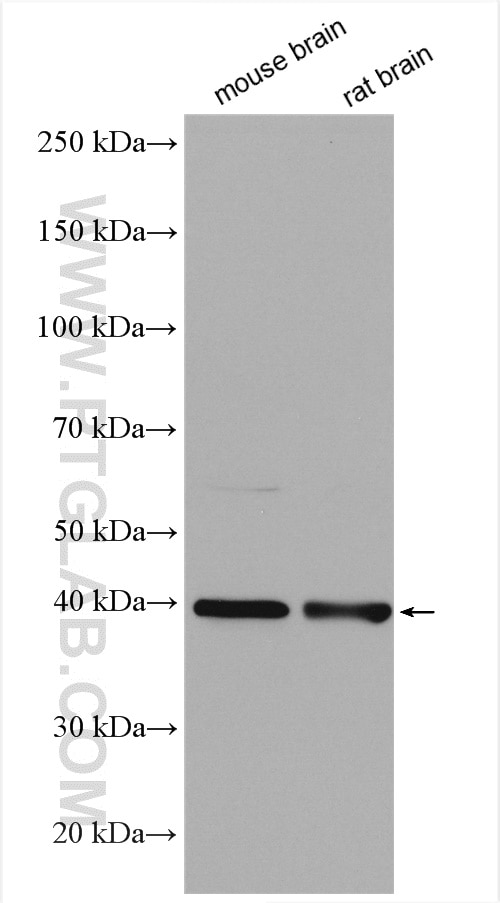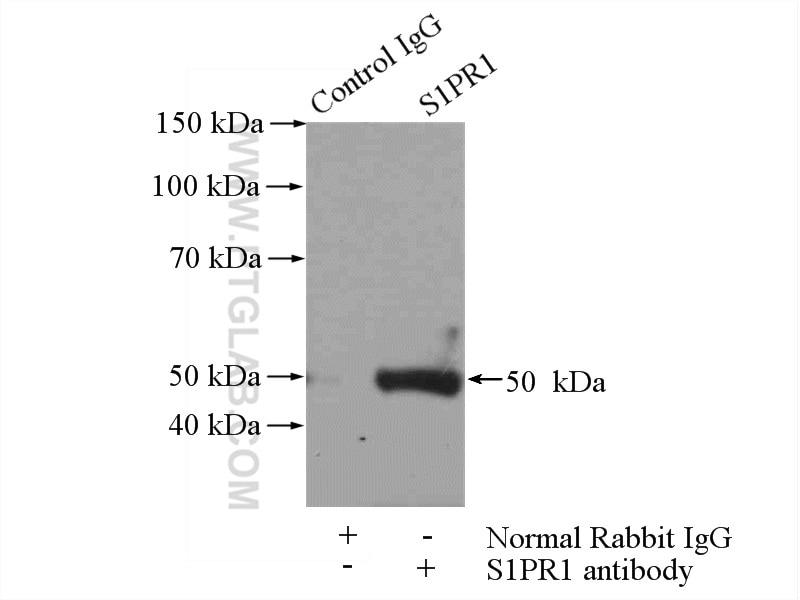- Phare
- Validé par KD/KO
Anticorps Polyclonal de lapin anti-S1PR1/EDG1
S1PR1/EDG1 Polyclonal Antibody for IP, WB, ELISA
Hôte / Isotype
Lapin / IgG
Réactivité testée
Humain, rat, souris
Applications
WB, IP, IHC, IF, ELISA
Conjugaison
Non conjugué
N° de cat : 55133-1-AP
Synonymes
Galerie de données de validation
Applications testées
| Résultats positifs en WB | tissu cérébral de souris, tissu cérébral de rat |
| Résultats positifs en IP | tissu cérébral de souris |
Dilution recommandée
| Application | Dilution |
|---|---|
| Western Blot (WB) | WB : 1:1000-1:6000 |
| Immunoprécipitation (IP) | IP : 0.5-4.0 ug for 1.0-3.0 mg of total protein lysate |
| It is recommended that this reagent should be titrated in each testing system to obtain optimal results. | |
| Sample-dependent, check data in validation data gallery | |
Applications publiées
| KD/KO | See 4 publications below |
| WB | See 26 publications below |
| IHC | See 6 publications below |
| IF | See 5 publications below |
| IP | See 2 publications below |
Informations sur le produit
55133-1-AP cible S1PR1/EDG1 dans les applications de WB, IP, IHC, IF, ELISA et montre une réactivité avec des échantillons Humain, rat, souris
| Réactivité | Humain, rat, souris |
| Réactivité citée | rat, Humain, souris |
| Hôte / Isotype | Lapin / IgG |
| Clonalité | Polyclonal |
| Type | Anticorps |
| Immunogène | Peptide |
| Nom complet | sphingosine-1-phosphate receptor 1 |
| Masse moléculaire calculée | 43 kDa |
| Poids moléculaire observé | 40-50 kDa |
| Numéro d’acquisition GenBank | NM_001400 |
| Symbole du gène | S1PR1 |
| Identification du gène (NCBI) | 1901 |
| Conjugaison | Non conjugué |
| Forme | Liquide |
| Méthode de purification | Purification par affinité contre l'antigène |
| Tampon de stockage | PBS avec azoture de sodium à 0,02 % et glycérol à 50 % pH 7,3 |
| Conditions de stockage | Stocker à -20°C. Stable pendant un an après l'expédition. L'aliquotage n'est pas nécessaire pour le stockage à -20oC Les 20ul contiennent 0,1% de BSA. |
Informations générales
S1PR1 (sphingosine-1-phosphate receptor 1), also known as S1P1 or EDG1, is one of five G-protein-coupled receptors for sphingosine-1-phosphate (S1P) (PMID: 18787560). S1P1 and its receptors have important regulatory functions in normal physiology and disease processes, particularly involving the immune, central nervous, and cardiovascular systems (PMID: 21339489). S1PR1 is widely expressed in various cell types, including endothelial cells and lymphocytes (PMID: 14737169). S1P-S1PR1 plays a major role in lymphocyte egress and chemotaxis, cell proliferation and survival, and tumor angiogenesis and metastasis (PMID: 21102457). The antibody is specific to S1PR1.
Protocole
| Product Specific Protocols | |
|---|---|
| WB protocol for S1PR1/EDG1 antibody 55133-1-AP | Download protocol |
| IP protocol for S1PR1/EDG1 antibody 55133-1-AP | Download protocol |
| Standard Protocols | |
|---|---|
| Click here to view our Standard Protocols |
Publications
| Species | Application | Title |
|---|---|---|
iScience Global sphingosine-1-phosphate receptor 2 deficiency attenuates neuroinflammation and ischemic-reperfusion injury after neonatal stroke | ||
Int Immunopharmacol Dexmedetomidine alleviates oxidative stress and mitochondrial dysfunction in diabetic peripheral neuropathy via the microRNA-34a/SIRT2/S1PR1 axis | ||
Front Cell Dev Biol The CAGE-MiR-181b-5p-S1PR1 Axis Regulates Anticancer Drug Resistance and Autophagy in Gastric Cancer Cells. | ||
Front Pharmacol Integrated Metabolomics and Network Pharmacology Approach to Explain Possible Action Mechanisms of Xin-Sheng-Hua Granule for Treating Anemia. | ||
Phytomedicine Geniposide alleviates VEGF-induced angiogenesis by inhibiting VEGFR2/PKC/ERK1/2-mediated SphK1 translocation. | ||
Front Pharmacol Coix Seed Oil Exerts an Anti-Triple-Negative Breast Cancer Effect by Disrupting miR-205/S1PR1 Axis. |



